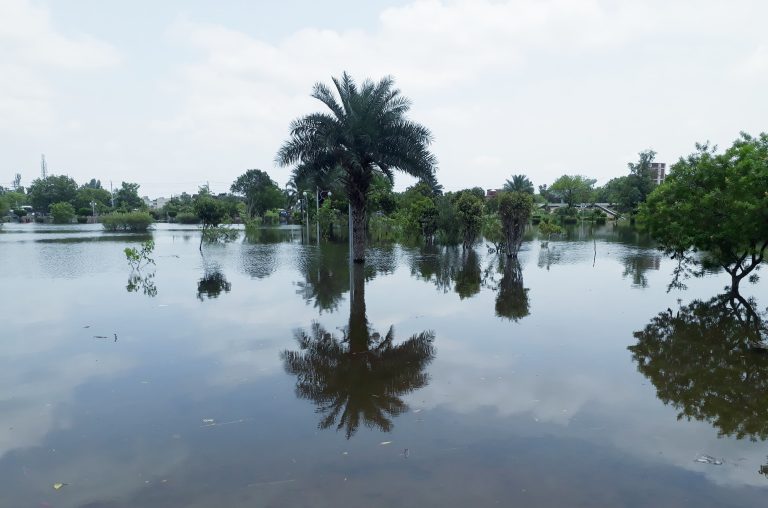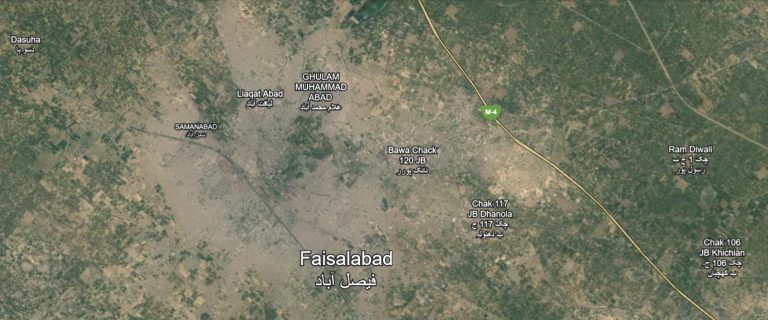Untreated Industrial Waste Water and sewage Silently Poisoning Faisalabad’s Groundwater

A few furlong from Faisalabad Bypass in the village of Malkhanwala, 55-year-old farmer Allah Rakha is preparing to irrigate his agricultural land by operating a tube well. Normally, farmers use tube wells to lift groundwater for irrigation. However, Allah Rakha uses his tube well not to extract groundwater but to draw water from a nearby sewage drain. “The filthy water I use contains human waste, urine, and toxic chemicals from factories. We don’t want to use it, but we have no other option,” says Allah Rakha, with a tone of resignation. He explains that the groundwater in the area has become excessively saline, making the land barren. Since his fields are located at the tail end of the irrigation system, he doesn’t have access to canal water either. According to him, before the sewage drain passed through the area, the groundwater was somewhat usable. But now, using it for irrigation results in poor crop yield and further deterioration of the land. This issue highlights the growing struggles faced by farmers in Faisalabad due to climate change and is intricately linked to the city’s failing sewage system and the chemical-laden wastewater discharged from factories.
The Role of the WASA in Groundwater Contamination
The primary culprit behind the ground water contamination is the vast industrial waste discharged by the city’s large-scale industries. This waste infiltrates the soil through the 1,711 kilometre sewerage network managed by WASA-Faisalabad, contaminating the groundwater. WASA’s sewerage system connects 34 disposal stations, which channel sewage through four major drains spanning 62 kilometres. The sewer drains, locally known as ganday naalay direct the polluted water eastward to the Ravi River via the Madhuana Drain and westward to the Chenab River through the Paharang Drain, thereby polluting both rivers and their ecosystems. Meanwhile, the city’s population boom over the past century has led to an increased reliance on groundwater. WASA-Faisalabad has also allowed 443 industrial units to extract groundwater, exacerbating the strain on this precious resource. Despite extensive use, there has been no significant effort to recharge the groundwater, resulting in a continuous decline in both its quality and availability.
The Role of the Textile Industry in Groundwater Contamination
Approximately 10 kilometres from Allah Rakha’s village, behind the large, closed gates of textile mills along Maqbool Road, thousands of yards of fabric are produced daily. These fabrics, with their vibrant colours and attractive designs, captivate buyers when displayed behind the gleaming glass windows of high-end clothing stores. However, few customers are aware that the creation of their favourite garments is contributing to the pollution of underground water, not just in Faisalabad but across the entire region. The roads surrounding these textile mills are frequently submerged in polluted water discharged during the dyeing and printing processes. None of the mills in the area have wastewater treatment plants. As a result, for years, mill owners have been dumping this toxic water directly into the Water and Sanitation Agency’s (WASA) sewage lines and storm water drains. Due to these ongoing issues, many residents have sold their homes and moved to other parts of the city. Those who remain complain that, despite decades passing, WASA has failed to find a lasting solution to this crisis. The mills’ untreated wastewater not only affects the urban and rural areas of Faisalabad but also severely contaminates ground water reserves and harms local wildlife. This polluted water flows through the city’s sewage lines and storm water drains, eventually merging into a large drain, known as Channel Four, located five kilometres outside the city. A few kilometres further, in the Gulzar Colony area, more textile mills operate, also discharging their untreated wastewater directly into Channel Four. The impact of this untreated discharge is evident: hundreds of acres of farmland adjacent to the drain are rapidly becoming barren as salts and chemicals accumulate on the surface, rendering the land unfit for cultivation.
How Sweet Groundwater Turned Toxic
A century ago, before the British established a new city in this region, it was known as Sandal Bar, a fertile land with abundant fresh groundwater. To settle the area, two canals were drawn from nearby rivers to irrigate agricultural fields, and a colony named Chenab Colony was founded. This laid the foundation for the new city of Lyallpur, now known as Faisalabad. Ironically, the very groundwater that once made this city an ideal place to settle is no longer sweet, nor is it fit for human consumption. The primary culprit is industrial waste water, which is being absorbed into the earth through drains like Channel Four, polluting the underground water reserves. Originally, these drains were constructed to collect and channel rainwater into the Chenab and Ravi rivers. However, for several decades, they have been repurposed to carry sewage and industrial waste out of the city. The south eastern part of the city discharges its polluted water through the Madhuana Drain into the Ravi River, while the north western areas send their waste via the Paharang Drain into the Chenab River. The untreated sewage and industrial chemicals flowing into the Chenab through the Paharang Drain have also contaminated the river water. Approximately 20 million gallons of wastewater flow daily through Paharang Drain and are partially treated at three large ponds constructed by WASA near Chokera. Here, solid waste settles at the bottom of the ponds, while the remaining water is reintroduced into the drain, eventually making its way to the Chenab River, further polluting its waters.
Ineffectiveness of WASA’s Wastewater Treatment
Environmental expert Farhat Abbas Kamoka believes that the system of ponds designed by WASA to treat sewage and industrial wastewater is far from a real solution. According to him, this so-called water treatment plant neither has the capacity to purify all the sewage and industrial waste nor does it eliminate the harmful chemicals in the water. Moreover, even the treated water is ultimately mixed back with the heavily contaminated water in the Paharang Drain, rendering the process futile. The level of pollution in the drain is evident from the point where its water merges with the Chenab River. The once muddy waters of the river turn black at the confluence, and the dry riverbed nearby are strewn with debris, including hospital waste and other garbage. A pervasive stench, typical of decaying chemical compounds, hangs over the area. The site is desolate, with no human settlements nearby, few birds in sight, and no signs of fish or other aquatic life in the river. A study by the Pakistan Council of Research in Water Resources (PCRWR), a government body, has termed this situation extremely alarming. According to a report by the World Wide Fund for Nature (WWF), the polluted water and industrial waste from Faisalabad entering the Chenab and Ravi rivers is contributing to the environmental and water pollution across the entire Sandal Bar region. These two rivers are not only critical for agricultural irrigation in Punjab but also provide drinking water to several cities and towns along their banks. A significant portion of the water seeps underground, replenishing local water reserves. Another study by PCRWR reveals that as a result of the rising pollution levels in the Chenab and Ravi, at least 42% of Faisalabad’s groundwater is now contaminated. The levels of cadmium in this water are three times higher than the limits set by the Punjab Environment Department, while chromium levels exceed the permissible threshold by ten times. Both cadmium and chromium are highly toxic to human health. The report further states that even the water treated by WASA contains both organic and inorganic compounds well above the medically safe limits. Farhat Abbas Kamoka places the blame squarely on Faisalabad’s industrialists. He states that at least 25% of the small and large industrial units in the city’s residential areas discharge dangerously polluted water. The Environment Department has already issued warning notices to these factories, along with deadlines to install water treatment plants and relocate outside human settlements. However, these measures have so far failed to yield any significant results.
Industry’s Rebuttal to Pollution Claims
Former President of the Faisalabad Chamber of Commerce and Industry, Mian Tanveer Ahmed, disagrees with the accusations made by local residents and environmental experts against industrialists. He claims that most of the major industrial units in the city have voluntarily taken measures to treat polluted water. However, he laments, “The unfortunate reality is that the treated water is being mixed back into polluted drains, negating our efforts.” He elaborates that “123 industries located within the city have installed water treatment plants with a collective capacity to purify over 800,000 gallons of water daily. Among these, 24 plants have the capability to treat industrial waste to 100% purity, while 99 plants can purify 50% to 60% of the wastewater.” Independent verification of these figures is nearly impossible, as most industrialists do not allow journalists inside their factories. Even if Mian Tanveer Ahmed’s claims are accepted at face value, the treatment plants still fall short of addressing the city’s total industrial wastewater output, which amounts to 573 million gallons per day. Thus, the treatment efforts cover only a fraction of the overall pollution.
The Unfinished Plan: Faisalabad’s Water Crisis
Thirty years ago, in 1993, Faisalabad’s master plan proposed a redesign of the Channel Four drain system to separate sewage from residential areas and rainwater. However, 27 years later, this project remains incomplete. According to Water and Sanitation Agency (WASA) officials, over 50% of the work on this plan has been completed, but finishing the rest requires at least 300 million rupees, a sum the department cannot raise on its own. They further claim that under WASA’s new 20-year master plan, a water treatment plant will be built in the city’s eastern region at a cost of 19 billion rupees. This plant will treat 44 million gallons of water daily, removing toxic chemicals to make it safe for human use. Additionally, the capacity of the existing treatment plant at Chakera will be expanded from 20 million gallons per day to 180 million gallons per day. However, these projects have been on paper for several years, and even WASA officials are uncertain when construction will begin. Even if implemented, more than 268 million gallons of untreated sewage and industrial waste would still flow into rivers daily, bypassing any treatment plants.
This situation is particularly alarming, given that Pakistan already ranks 14th among countries facing severe water scarcity. With the escalating threats posed by climate change, the urgency of protecting the country’s rivers and groundwater from pollution is more critical than ever. Immediate and sustainable action is needed to safeguard these water sources from sewage and industrial waste. Any further delay in addressing this issue could pose a significant threat to the survival of both human populations and the natural environment in the region.



